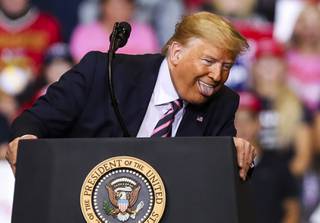
SUN FILE AND ASSOCIATED PRESS PHOTOS
Clockwise from right: Joe Biden, Amy Klobuchar, Bernie Sanders, Pete Buttigieg and Elizabeth Warren are vying for the Democratic Party presidential nomination. Whichever candidate wins it will likely be back in Nevada during the general election campaign.
Monday, Feb. 24, 2020 | 2 a.m.
Related Content
Nevada, it’s time to catch our breath.
After more than one year of presidential campaign events, candidate visits and knocks on our doors, Nevadans have finally selected their candidate for the Democratic presidential nomination.
And now that our caucuses are over, the candidates will flock to South Carolina and, eventually, the Super Tuesday states and beyond to pitch their message. The constant churn of events locally will taper off and Nevada will be left an observer for the rest of the nominating process.
But once the nomination is set in July, it will likely be a different story.
Ken Miller, an assistant professor of political science at UNLV, said that while ours is not the most important of the battleground states, Nevada will receive attention from both President Donald Trump and the eventual Democratic nominee.
That means more visits, rallies and advertising messages, following a pattern set by the past three presidential cycles, when candidates or campaign surrogates made frequent trips here in hopes of securing the state’s Electoral College votes.
“For Nevada, we’re going to stay relevant,” Miller said. “We’re bluish-purple, so we’re in the battleground category. With the electoral map the way it is now, we’re sort of toward the middle of that battleground set (of states).”
Nevada has voted blue in recent presidential elections — the state backed Barack Obama for president in 2008 and 2012, and Hillary Clinton in 2016. In addition, voters in 2018 sent Democratic Sen. Jacky Rosen to Washington, D.C., along with two new Democratic representatives, Steven Horsford and Susie Lee.
There’s only one Republican member of the state’s congressional delegation, Rep. Mark Amodei, and only one statewide Republican officeholder, Secretary of State Barbara Cegavske.
However, Nevada voters chose Clinton by one of her slimmest margins of victory in the 2016 race, at 2.4%. That gives the Trump re-election campaign reason to identify Nevada as one of at least four states it can flip this year, including New Mexico, New Hampshire and Colorado.
“With your help this November, we will beat the radical Democrats,” Trump said Friday during a rally at the Las Vegas Convention Center. “We are going to win Nevada in a big, beautiful landslide.”
Nevada Democrats outnumber Republicans in voter registration, about 698,000 to 587,000. But while turning out the base matters, there’s also a veritable sea of potential voters registered as nonpartisan — almost 424,000.
“I think we’re a couple of election cycles away from being perceived as comfortably blue,” Miller said. “And that’s just if the trend continues.”
Miller and UNLV political science professor Dan Lee said nonpartisan voters would be targets for candidates.
“There’s enough weak partisans in the state that you’re still going to see some persuasion efforts,” Miller said.
He added that in-person appearances would likely do little to persuade undecided voters. An information campaign, he said, would be a better way to reach voters. In 2016, both candidates spent good money in the market, with Trump pumping in $792,000 between the Republican caucuses and Election Day, and Clinton spending around $1.23 million between the Democratic caucuses and Election Day, according to filings.
“That (battle) will be primarily fought over advertising,” Miller said. “Appearances are for the base.”
Keith Schipper, the GOP’s communications director for Nevada, said Trump not having to focus on campaigning against an intra-party challenger gives him an edge in the state. Democratic campaigns, he said, will likely have to wind down or disperse into other states until a nominee is chosen.
“We still have a presence here,” Schipper said. “We’re still going to be working up until November.”
Having a good showing in Nevada would also likely affect down-ballot races, as more voters turn out for presidential elections than midterms, and, therefore, large turnout for a candidate can trickle down to other races. While the state’s heavily blue 1st and heavily red 2nd congressional districts would be difficult to flip for either party, the 3rd and 4th districts have been represented both by Republicans and Democrats in the recent past. Congressional candidates will likely link themselves to their parties’ nominee o drum up support from their backers, as well.
Nationally in 2016, the Democrats’ “blue wall” — the term for the formerly staunchly blue states of Minnesota, Wisconsin and Michigan — partly fell, leaving Minnesota as the only Democratic holdout in the Upper Midwest.
This has left Democrats looking at multiple paths to the presidency. Central to almost all of the combinations of states that could get the party to 270 electoral votes, and therefore the presidency, is maintaining support in all states that went for Clinton in 2016. That includes Nevada.
It also includes the states that were expected to go for Clinton but flipped to Trump, like Wisconsin, Michigan or Pennsylvania. These states, Miller said, will draw considerable attention during the general election campaigns. While Nevada might not get as much as them, he said, it will not be overlooked.
“OK, fine, we’re not quite as important as Wisconsin or Pennsylvania, but we’re that next tier,” Miller said. “So, we’re going to get a lot of attention.”

